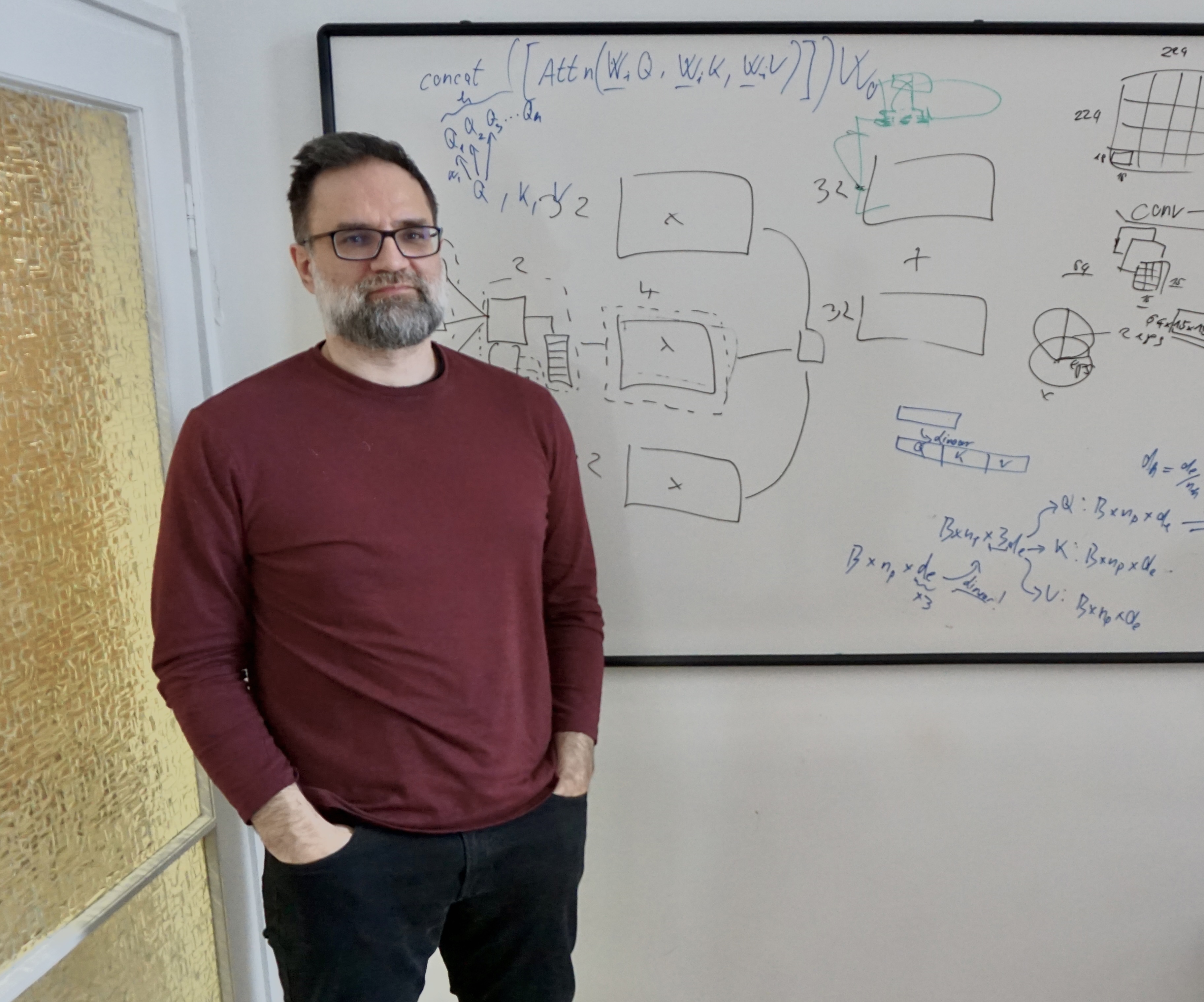Inside Hungary’s Cutting-edge Artificial Intelligence Research Group

Professor Márk Jelasity, who heads the Szeged-based ELKH-SZTE Research Group on Artificial Intelligence.
It may come as a surprise that a quiet riverside university town in Hungary’s southeast is a hotbed of artificial intelligence research. In fact, Szeged, specifically its much-heralded university, is home to the ELKH-SZTE Research Group on AI. An academic entity with its origins in the 1960s, it is currently a platform for cutting-edge work on the application and potential of artificial intelligence across a range of sectors.
Dr. Márk Jelasity, who currently heads the group of around 20 researchers, including permanent staff, associates and graduate assistants, spoke with the Budapest Business Journal from his office in the Informatics Institute, a large and elegant stone structure on Szeged’s Árpád tér, and one of the many historical university buildings in the city’s downtown.
Jelasity, who also heads the university’s AI department, characterizes the group’s three main research areas: natural language processing, image processing, and AI security problems.
Work on language processing problems began in the 1990s, primarily concerned with the idiosyncrasies of the Hungarian language and later with speech recognition. More recently, they have turned their attention to speech processing, which includes speech-to-text applications but also more precise tools that delve into what are called paralinguistic problems.
With the help of AI, Jelasity explains, “You can detect lots of things from speech; for example, you can detect certain diseases or whether a person is drunk or not.”
Such a tool functions by picking up the generic patterns of speech specific to certain conditions of ill health, he adds. In the case of depression, this is based on a database of speech samples produced by people with and without the disorder. Thus, the tool functions for anyone without the need for individual fine-tuning.
“Such a tool, when applied to one’s phone, could be very practical because your phone hears you all the time,” he points out. “Based on what it detects from your speech, it could warn you or advise you to visit the doctor for a check-up.”
In another field, much of the group’s work has focused on image recognition tasks involving image segmentation and object detection. This line of research is relevant for developing self-driving cars, as well as medical diagnosis and computer-assisted surgery. It also has military applications such as surveillance and targeting.
Medical Research
“For us, a big thing is the medical area,” Jelasity says. “So, we work locally with hospitals, and there are several groups. I think it’s a very big and promising area for application, which is obviously very useful. And it’s challenging, but it’s also promising.”
Among the challenges Jelasity and his colleagues face in AI-assisted medicine is resistance from some in the medical community itself.
“Some doctors fear becoming irrelevant because of AI,” he says. “And it’s a real risk because in many cases, for example, from a blood test, an AI can pick up a lot more information, like correlations. Doctors typically look at the thresholds of certain things, but there are a lot more complicated patterns. And maybe it’s not so easy to pick up for them.”
An article authored by members of Jelasity’s group on the use of machine learning to detect and segment microscopic muscle structures is currently cataloged for reference by a division of the National Institutes of Health in Washington, D.C. It is one of more than 1,000 papers published by the group since 1981.
The same complex technology that empowers large language models (LLMs), the architecture behind ChatGPT and many of the AI systems currently in use, is also proving to be their leading shortcoming, says Jelasity. It has also opened an important area of research for his group: AI security.
According to Jelasity, LLMs are deep neural networks consisting of many layers that analyze extensive data sets and then make predictions based on that for currently unknown data. This enables them to perform tasks such as natural-sounding conversations or pilot a drone. But when they make mistakes, it can be challenging to find out why and to correct it. What’s more, feeding them specific small data currents can be enough to mislead them wildly.
“AI systems are known to be extremely sensitive to certain input manipulations,” the professor says. “So, you can change the inputs of a system very, very slightly, in an invisible way essentially. And then, you can create an output to your liking. Basically, you can make the systems do anything you want if you have enough access to them.”
Knitted Defense
Jelasity gives the example of an Italian startup called Cap_able which has designed a line of knitted garments that it claims will protect you from facial recognition software.
“I find it very useful to think about that because, to me, these security problems are indications that something is off with the system,” he said. “These are problems that you shouldn’t have, essentially.”
Because deep neural networks, the key technology under the hood of modern AI systems, are so complex and are constantly teaching themselves, debugging them when they do fail is much more complicated than with earlier systems coded by humans. As a result, Jelasity views this concept of AI policing as an area of research with a lot of promise.
“There are lots of techniques that you can use, certain training techniques and all sorts of things to prevent this, but it’s far from being solved,” he says.
In addition to the work being done by his group on the medical, transport, and security sectors, Jelasity says other departments within the Institute of Informatics collaborate with multinational businesses in Hungary, such as Samsung, among others.
When asked how businesses seeking to harness the power of AI while avoiding its pitfalls should proceed, Jelasity is quick to give his recommendation.
“My advice, of course, would be to hire people with Ph.D.s, particularly specific to AI, because I believe that the information flow from academics into businesses is through people essentially. And the best forum is if you hire somebody who specializes in this area and has links with academia and the latest research.”
This article was first published in the Budapest Business Journal print issue of June 16, 2023.
SUPPORT THE BUDAPEST BUSINESS JOURNAL
Producing journalism that is worthy of the name is a costly business. For 27 years, the publishers, editors and reporters of the Budapest Business Journal have striven to bring you business news that works, information that you can trust, that is factual, accurate and presented without fear or favor.
Newspaper organizations across the globe have struggled to find a business model that allows them to continue to excel, without compromising their ability to perform. Most recently, some have experimented with the idea of involving their most important stakeholders, their readers.
We would like to offer that same opportunity to our readers. We would like to invite you to help us deliver the quality business journalism you require. Hit our Support the BBJ button and you can choose the how much and how often you send us your contributions.










